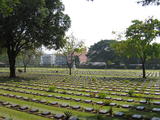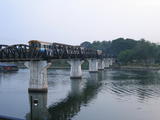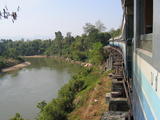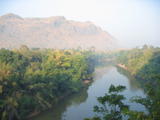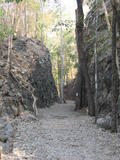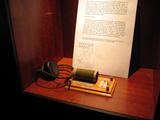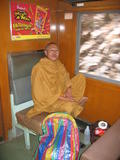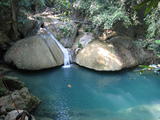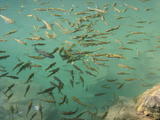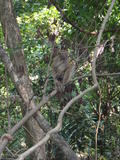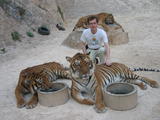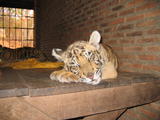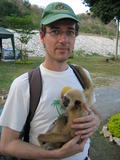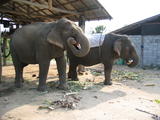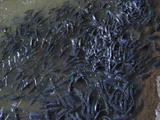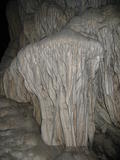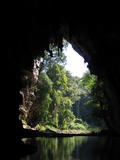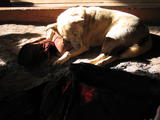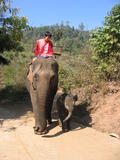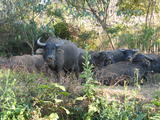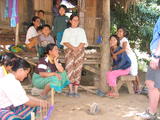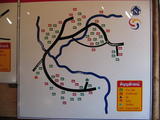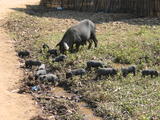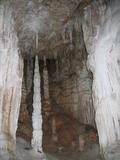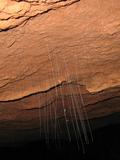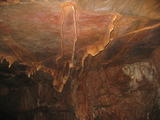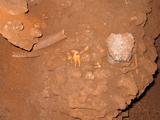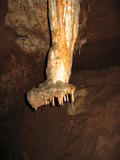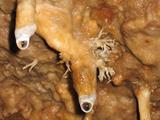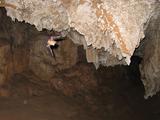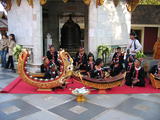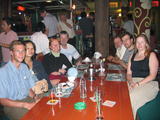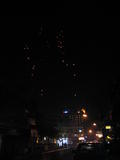| < < < Previous story | Next story > > > | |
The bridge on the river Kwai, caving in Northern ThailandBangkok, 7 Feb 2005
Contents:ThailandWe spent the first few days in Bangkok gathering information about potential next destinations, including trying to find out how to get visas for all the neighboring countries and how best to get there. My brother and his girlfriend were going to join us in the middle of December for a week or two. Although Bangkok is a good place from which to organize onward travel, we did not want to spend another week there waiting. So we chose to spend that week in nearby Kanchanaburi, a town that I absolutely wanted to visit anyway. Bridge on the river KwaiKanchanaburi's claim to fame is that it is where the bridge on the river Kwai is said to be. This bridge was made famous by a movie in 1957 about the infamous Burma railway line, which was built in the Second World War during the Japanese occupation of Siam (now Thailand) and Burma (now Myanmar). At completion it was 415 km long joining existing rail lines from Bampong in Siam to Thanbyuzayat in Burma. 130 km of the line is still in use today. The Siamese section was built along the river Kwai (sometimes spelled Kwae), which is now known as the river Kwai Noi. When the movie "Bridge on the river Kwai" was made the bridge near Kanchanaburi was actually on the river Mae Khlong. In 1960 the Mae Khlong was apparently renamed to Kwai Yai. This cast some doubt on the claim that the Kanchanaburi bridge is the "real" bridge on the river Kwai! Of course the bridge really was part of the Burma railway line and played an important role in its history. Forced laborers from South East Asian countries and Allied POWs were used to build the railway line. Of the more than 300,000 people made to work on the line over 60,000 were Allied POWs of which about 30,000 were British, 13,000 were Australian and 18,000 were Dutch. Because of the terrible conditions under which they had to work and the brutal treatment they received from their Japanese captors, more than 100,000 people died building the Burma railway line. Most of the victims fell amongst the forced laborers from South East Asian countries and about 15,000 were Allied POWs, mostly from the United Kingdom (6,500), Australia (2,700) and the Netherlands (2,800). But more than a historical site with nice surroundings, this place has a deeper meaning for me, as my grandfather was one of those POWs! It was a period of his life that he never really liked to talk about. The town's two museums and the Hellfire Pass Memorial made me realize how bad the situation was and understand that these are not memories my grandfather would have liked to rake up. Gruesome detail after detail is exposed. Hellfire Pass Memorial, besides a museum maintains a disused stretch of the railway as a walking path. It is an impressive stretch to walk along. It is called Hellfire Pass, because the POWs had to work there through the night using the light of fires in order to complete the line within the timeframe set by the Japanese. The Japanese military did not fulfill their obligation under international conventions to keep records on POWs. Instead the POWs kept their own records, some of which were buried with the deceased. Hence after the war, most POW graves, which were scattered around 140 burial sites, were found and identified, their remains exhumed and reburied in one of the three war cemeteries along the railway line. The two graveyards in Kanchanaburi are immaculate, being maintained by the POWs' home countries. It contrasts somewhat with the more chaotic surroundings. Visiting the graveyards I could not help to think which of those men my grandfather might have known. Asian laborers who died working on the railway, did not have the organization that the POWs, who were part of an organized army, had. They had been plucked randomly off the street by Japanese soldiers. While some of the POWs were doctors, Asian laborers had no doctors amongst them. It is said that only 3 Asians had their remains identified positively, while the exact number of dead Asian laborers will remain forever unknown, it is estimated that up to 90,000 of them died. In further contravention of international treaties, the Japanese Imperial Army made the POW camps look like army barracks, so that Allied bombers would target them by mistake. At least 200 POWs died that way. Similarly boats transporting POWs were not identified, and many were attacked and sunk by Allied airplanes. As I wrote in our travel story on Nagasaki, my grandfather had been condemned to death by the Japanese, for having smuggled a small radio into the camp. His life was saved by the sudden end of the war before the sentence was carried out. Something for which he has always been very thankful. But little did I know before visiting the Kanchanaburi museums that the Japanese Imperial Army had issued orders to execute all Allied POWs in the event of an Allied landing in the region. Such an order had already been carried out in the Philippines. Believing such an attack was imminent the Japanese Army had already forced some Allied POWs to dig the holes in which they were going to be buried. Thanks to the sudden and unexpected end of the war, with the bombing of Hiroshima and Nagasaki, all POWs in the region (in the 100,000s) escaped certain death! Northern ThailandBarely an hour after returning to Bangkok, we ran into my brother, Jan, and his girlfriend, Angie, on Khao San Road. That was good, no need to go looking for each other. They wanted to go to the hills of Northern Thailand, more specifically Pai and Soppong, which was fine with us. Although there really is nothing spectacular in and around Pai, it is a relaxed place where many travelers crash for days, weeks or even months. You can rent bicycles to explore the surroundings and spend an afternoon at the nearby hot springs. Elephant rides are on offer, but the elephants are controlled by their mahouts with sticks and metal hooks. When not riding they are chained to poles with hardly any room to move. Unfortunately 100 US Dollars was stolen from the security box of our hotel. I noticed something was wrong when I got the bag back because the contents was no longer the way I had placed it. We called the police. After a few hours the hotel manager offered to refund our loss, because she said she felt responsible. But I have a suspicion that it was the hotel staff that stole it, most people might not check properly and will be long gone before they notice anything is missing, others don't have time to go to the police because they have to move on. Those who do discover it are simply refunded, which is no loss to the staff! At the police station I discovered a less pleasant side of Thailand, they wanted me to sign a document in Thai, but when I added the text "I do not understand Thai" next to my signature, The police got into a rather nationalistic spin, about how their document was now "polluted" with a foreign language and that it was an insult to their King. I thought it rather insulting that the English was considered so inferior as not to be worthy to placed on Thai paper. I pointed out that I did not write it in my native Dutch, but in English so that they could understand, while I could not understand any of the Thai text and that I was in no obligation to sign a document I could not read anyway. Not that reasonable explanation helped, but they eventually got tired of not being able to impress me with the "seriousness" of the situation and forgot about it. Tham LodTrying to forget the unfortunate incidents in Pai and the darker side of Thailand it had exposed, we traveled to Soppong, from where we took a car to the Cave Lodge near Tham Lod (Lod Cave). Originally planned for just a day or two, it was such a pleasant place that we stayed 6 days. The Cave Lodge is run by Australian born John Spies who has turned it into one of the most relaxed places to stay, he provides lots of information on all the activities that are possible around the lodge. Tham Lod (Lod Cave) is actually a river flowing through a mountain. It is possible to enter from one side and exit from the other, or even raft through it. There are a few coffins in the cave said to be 2000 years old as well as a prehistoric drawing which is no longer discernable. It has been wiped out by a village kid during a graffiti cleanup action. Unfortunately this was Thailand's most beautiful prehistoric drawing! Close to the exit of the cave (that is the side where the river flows out), about 300,000 swifts and a few bats nest. At sunset the swifts return en masse, while the bats are desperately trying to fly out against the traffic! If you venture too far into the cave at this time you will be showered by a rain of bird droppings. As it was full Moon on Christmas day, the Cave Lodge owner John, organized a special "full Moon kayaking". With just the moonlight and a torchlight, being unexperienced at kayaking we went down the river, hit a big tree trunk, capsized before we got near the cave. Maris lost her shoes. We continued none the less, entering the quiet waters of the cave, drifting slowly through the cave, the torchlights of the kayaks in front and behind us lit up the cave ceiling. At the cave exit John greeted us with "are these your shoes?". The current had washed them all through the cave, where he found them. Besides Tham Lod, there are some 200 caves in the area. On Christmas day we visited the easily accessible chambers of Christmas cave together with many of the Cave Lodge's guests. Later, one of the guests, Ken, an experienced caver invited me to join him in exploring Christmas cave further. I accepted. This was my first independent caving experience. There was a stream going through the cave. I surprised myself by what I dared to do, as at one point you needed to duck your head under water to reach the next chamber. Originally I was scared to do this, but Ken went ahead and when I saw the light on the other side through the few centimeters of air between the water level and the ceiling I thought that I could do it too. Of course the thought of not being able the put your head up out of the water to breathe, as the ceiling of the cave prevents you from doing that and the uncertainty of encountering stalactites that might block your way made for a lot of excitement. I ducked my head under water and swam for about three 3 meters towards the light that Ken was holding. When I lifted my head, no ceiling stopped me. I made it! I decidedly liked my first caving experience. New guests Jil and Pam also wanted to go caving so Ken and I joined with them for an exploration of 3 other caves with a local guide. Fossil Cave (there's a stone with fossilized shells), Spirit Cave (there are coffins) and waterfall cave (there is waterfall in the cave). I didn't know at the time that we were standing at the top of the waterfall in the cave, that in 2001 a guest from the Lodge had fallen to his death down that same waterfall. It took 3 days to recover his body! On our last day we explored what we thought was Turtle cave (we still don't know for sure). It was getting dark outside, as I stood up in a chamber after crawling under a lowered ceiling a bat flew straight at my face. I ducked. Of course at sunset these creature wake up, trying to get out. We sat against a wall, turned off all the lights and enjoyed the flapping of the bat wings, sometimes, feeling the air on our face. When we turned on a light, we saw the chamber filled with bats flying around. Besides the bats that we saw in all the caves, the caves were also inhabited by spiders the size of a human hand! After nearly a week at the Cave Lodge, we returned to Chiang Mai, coincidently so did many of the other guests. We celebrated New Year, with Mike ("it is Britain not England" from Britain), Ken (from the U.S.), Steve (from Canada), Celine (from Quebec, she would kill me if I wrote the C-word) and last but not least Noi, Mike's Thai girlfriend, who invited all of us into her home for a traditional Thai New Year celebration. Even though the New Year celebrations were somewhat subdued due to the tsunami, it was interesting to see how New Year is celebrated in Thailand, or at least in Northern Thailand, where we observed it. Thin paper hot air balloons, the hot air created by burning paraffin are let go into the night sky, making it look like the sky is full of bright stars. It would probably be illegal in Europe because of the fire hazard, as the things can easily come crashing down on somebody's roof and set their house on fire! In spite of that risk, we proceeded to release our own paper balloons. TsunamiAs we returned to Chiang Mai, we connected to the world again, we started to realize how terrible the tsunami had been. At the Cave Lodge we had been more or less cut off from the world, we found out nearly a day after the event what had happened and only received sporadic bits of information after that. We were unable to send any outgoing messages, except when my brother returned to Bangkok and promised to call our parents, when he would reach an area with cell phone cover, to tell them that we were all OK. Back in Chiang Mai the cable news channels made it look like the entire country had been destroyed, yet here we were in Thailand and everything continued as before. Life went on, interrupted occasionally by news of even higher death tolls! If you would like to be notified or no longer want to be notified of our travel updates please e-mail me. e-mail Otto de Voogd PhotosKanchanaburiTham LodChiang MaiPractical Information
To my knowledge the information provided here was accurate
at the time of our visit. However time passes and things can change.
VisaThailand: 30 days visa-free. MoneyThailand: all ATMs work fine. TransportThere are at least 3 low cost carriers in Thailand:
In Bangkok always use metered taxis, this is lot cheaper than fixing the price per ride or taking a tuk-tuk. The fixed prices quoted by cab drivers are generally a factor 2 to 3 higher than what we ended paying with another cab driver that did agree to use the meter. Tuk-tuks have a bad reputaion, which I dare say they deserve. CostsThailand - Baht, approx. rates: 1 USD = 39 THB, 1 EUR = 52 THB
Airport Bus: 100 THB
| ||
| < < < Previous story | Next story > > > | |
New | About | Contact | Connect | Friends | Promotions | Copyright | Advertise
